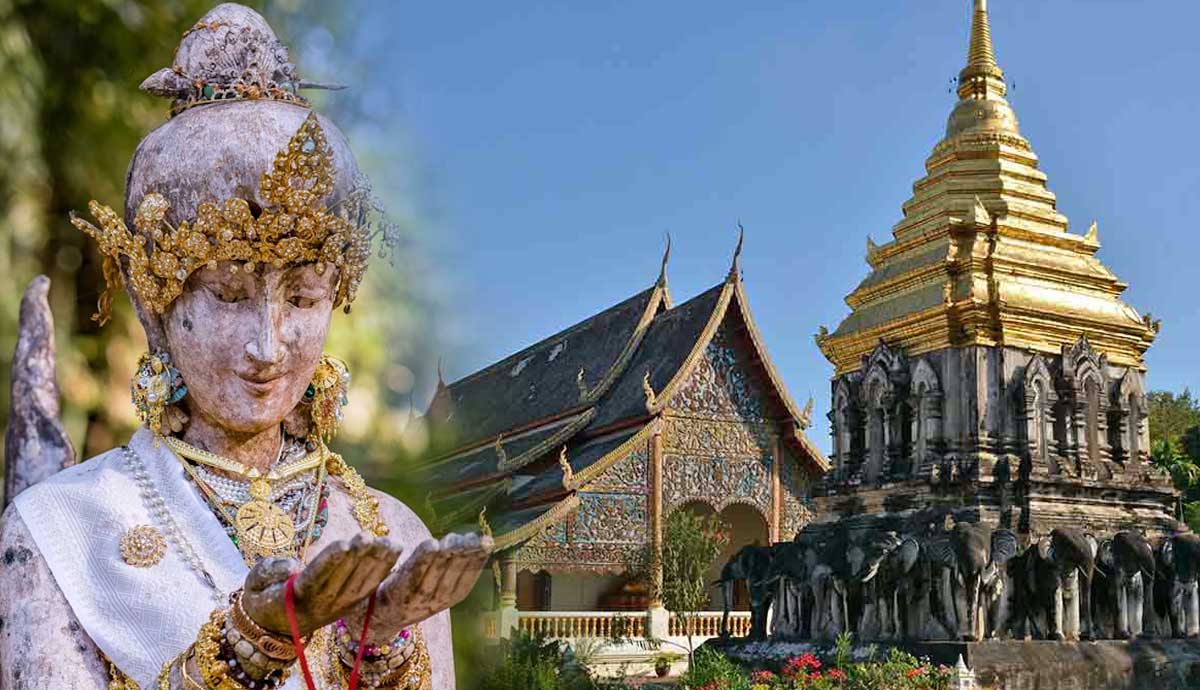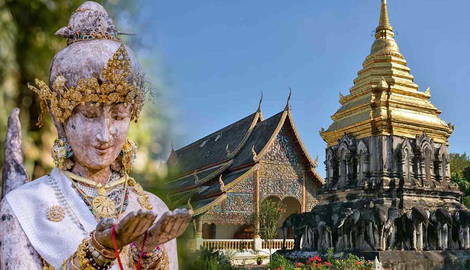
Chiang Mai, the second largest province in Thailand and the epicenter of education in Northern Thailand, is a mashup of captivating cultural experiences, mouthwatering food, and stunning architecture. As the capital of the Lanna Kingdom until 1558, Chiang Mai intermixes its traditions and culture with a modern flair. A trip to Chiang Mai will have travelers walking inside ancient city walls while slowly meandering night markets filled with local handicrafts and stopping at delectable restaurants. It is easy to see why Chiang Mai welcomes millions of visitors yearly and is a must-stop on any Thai itinerary.
1. Tha Phae Gate

History draws visitors to Chiang Mai, and the most impressive piece of it is the Old City, which begins at the massive Tha Pha Gate. This stunning landmark dates back to the 13th century and reaches a height of 25 meters (82 feet). The 1.5 km (1 mile) area it encloses is the city’s top destination for hotels, shopping, and fabulous food choices.
Constructed initially after the city’s founding in 1296, King Magrai erected the gate as a defense mechanism against invasions from the Mongols and the Burmese. “Tha Phae” translates to “raft landing” due to the historic gate’s function as a point on the Ping River where goods came through customs into Chiang Mai. The gate is one of four of the city’s original and served as a checkpoint for traders and the preeminent entrance for monks and diplomats into the city’s walls.
Due to erosion, the gate and the walls of the Old City have undergone many renovations in their long history. Revived in the 1980s, the current iteration of the gate now beckons millions of tourists through its threshold each year.
The gate and the adjacent square are key tourist attractions in Chiang Mai. It is the intersection of life in the city, with street vendors, festivals, and two famous night markets. The structure is a symbol of the city’s resilience and longstanding history.
2. Wat Chiang Man

There are over 300 temples or wats in the city of Chiang Mai and its surrounding area. With so many options, narrowing down the must-visit wats can be challenging for visitors, and Wat Chiang Man is one of those must-see historical attractions in the city.
Wat Chiang Man is the oldest temple complex in Chiang Mai. It was originally built by King Mengrai, the founding ruler of Chiang Mai, in 1296. However, the building was not a temple at first but a palatial residence for the king as he helped construct the city.
The complex’s most noticeable architectural feature, and oldest part, is Chedi Chang Lom, with fifteen life-size elephant-shaped buttresses holding up the base made of stucco and brick.
The temple’s complex is a mashup of Lanna and Burmese architectural elements. It also houses Chiang Mai’s oldest Buddha images. One of the temple’s two viharas, or sermon halls, holds a Buddha image dating back to 1465.
The complex also contains other notable artifacts, including a temple library and Buddha statues believed to have been originally brought to the structure by King Mengrai himself.
Wat Chiang Man is an easy stop when walking around the storied city. It is located inside the Old City’s walls, so it is easy to find a reason to pass by this temple on the way to the city’s other destinations.
3. Wat Phra That Doi Suthep

Chiang Mai has so many wats that any architecture lover will not be disappointed. However, with so many on offer, it can be challenging to discern the best ones to visit. Most agree that travelers can only genuinely say they have been to Chiang Mai if they have seen Wat Phra That Doi Suthep, located 11 kilometers (7 miles) outside the city center.
The sacred golden temple, one of the most sacred in Northern Thailand, was erected by the Lanna Kingdom’s King Keu Naone in 1383. The king built it to enshrine a piece believed to be the Buddha’s shoulder bone. Historically, it is thought that the King picked the location after the death of a white elephant, a revered symbol in Thailand, dropped dead there while carrying this sacred bone after being brought to the region by a monk from Sukhothai.
Wat Phra That Doi Suthep showcases the best of Northern Thailand’s architecture. It features a 306-step staircase flanked by mythical sea serpent statues (nagas) on either side. In addition to its historical significance, Wat Phra That Doi Suthep offers a beautiful panoramic view of Chiang Mai and a museum for religious pilgrims and tourists.
4. Wat Chedi Luang Varavihara

Chiang Mai is not a city of large buildings, as new buildings in the city area are not allowed to be over 15 meters (50 feet) tall. Due to this regulation, the Wat Chedi Luang Temple soars above the rest of Chiang Mai’s skyline at 98 meters (321 feet) tall. The site is also called the “Temple of the Big Stupa” due to the massive structure’s diameter of 54 meters (177 feet).
This stunning structure dates back to the 14th century. It was constructed under the rule of King Saen Muang Ma to hold his father’s ashes in 1391. In 1461, the temple’s construction was completed, and Wat Chedi Luang became the largest structure in the Lanna Kingdom.
The temple is most notable for being home to the significant Thai religious artifact, the Emerald Buddha, from 1468 for over a century. The Emerald Buddha was only rehomed after an earthquake hit in 1568 and rocked the temple’s structure. The earthquake caused over 30 meters (98 feet) of the structure to collapse. This event left the area without its main space of worship, which affected the community both religiously and economically.
After undergoing controversial renovations that focused less on preserving the original Lanna architecture and more on Central Thai elements, the temple is a marker of resilience in the region.
Today, the temple still functions as a place of worship and protection for Chiang Mai and is a significant tourist attraction.
5. Tham Chiang Dao

For a bit of a different historical experience, visitors should take some time out of their shopping and temple extravaganza in Chiang Mai and find their way to Tham Chiang Dao.
Tham Chiang Dao, located about 1 hour and 30 minutes outside the city near the third-highest mountain in the region, is one of the most studied caves in Thailand. It has been an archaeological site of importance for over 1,000 years.
The limestone cave is integral to Northern Thai myth and religion and is home to fascinating biodiversity. Many unique species help create the flora and fauna nearby.
The cave houses a small, beautiful temple near its entrance. In 1635, the Burmese also constructed Buddha images inside the cave’s entrance.
The cave and adjoining temple make for a stunning day trip from Chiang Mai. It provides an excellent mix of culture, topography, and history unlike anything else in the many temples in the city’s center.
6. Wat Pha Lat

Wat Pha Lat is another important wat in Chiang Mai. It shares a story similar to the more famous Wat Phra That Doi Suthep, as Wat Pha Lat was also constructed based on the story of the white elephant carrying the Buddha. Wat Pha Lat was one of the stops the white elephant made along the way, and a temple was erected during the reign of King Keuna in the 14th century.
Compared to other wats in Chiang Mai, Wat Pha Lat is less crowded and surrounded by nature, which gives it a more serene atmosphere. It is as if the temple grew out of the earth. Most notably, the temple’s grounds house a stream and waterfall perfect for meditation.
Visitors and religious pilgrims alike can hike up the “Monk’s Trail” to discover two of Chiang Mai’s temples. Wat Pha Lat is the easiest to reach on the trail, as visitors can hike up to it in about 45 minutes to one hour. If hikers are looking for another challenge, they can continue on the trail and see Wat Phra That Doi Suthep as well. However, the round trip would take at least five hours.
7. Wat Si Suphan

Arguably the most unique temple in all of Chiang Mai is Wat Si Suphan. This shimmering temple, also known in English as “the silver temple,” is hard to miss as it shines in the Thai sun.
The silver structure, originally built in the 16th century during the Mangrai Dynasty, was not always so striking. It was built more traditionally and contains an ordination hall where monks are ordained.
It did not come into its current iteration and lustrous form until 2016. After many renovations throughout its history, it was decided in 2004 to create its more current look. Chiang Mai’s artisans began the painstaking task of hammering together elaborate designs in aluminum, silver, and nickel. The metals were molded to create impressive silver murals.
The silver scenes depict Buddhist stories and snapshots of Thai life as well as the history of the temple itself. Today, the temple is a gathering place, school, and even an education spot for silversmiths. One unique activity available at the temple is the weekly “monk chants” or meditation sessions, which allow visitors to get a look into the daily life of one of the monks.










